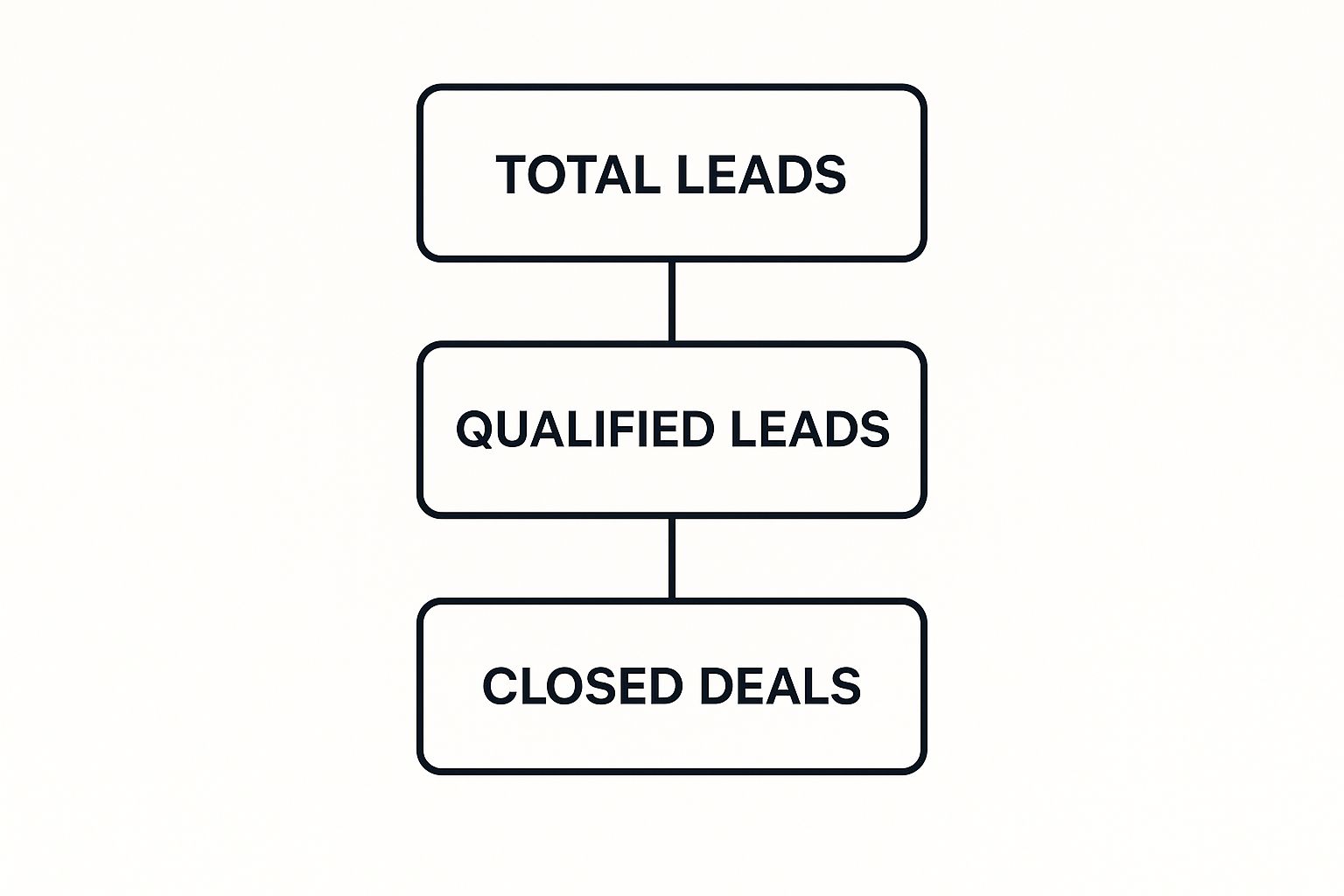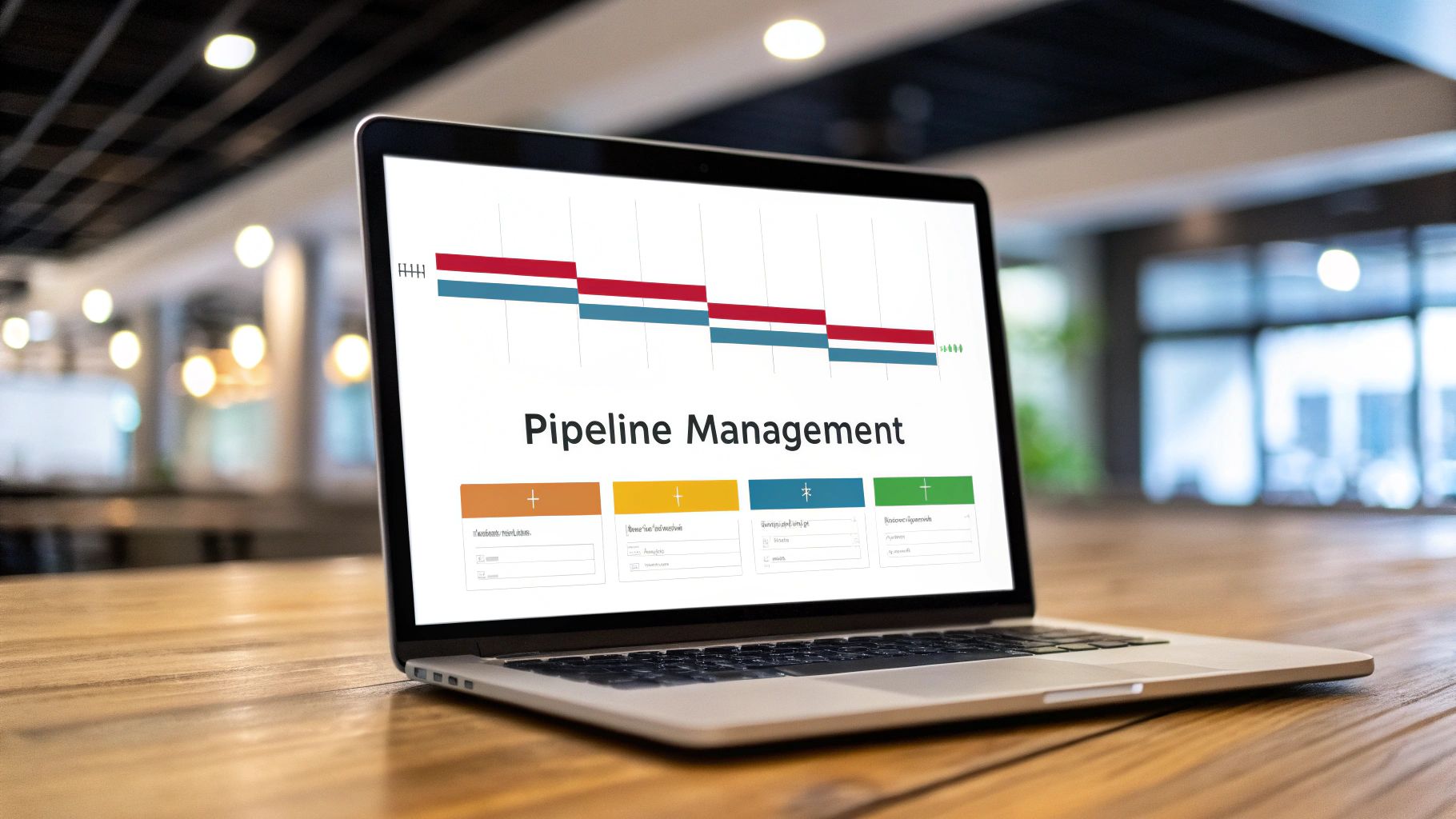At its core, a pipeline in sales is simply a visual snapshot of where all your potential customers are in their journey to buying from you. It takes the entire sales process and breaks it down into clear, easy-to-follow stages. This helps your team see every opportunity, forecast revenue, and know exactly what to do next to get a deal over the finish line.
What a Sales Pipeline Really Means for Your Team

Let's ditch the textbook definitions for a second. Think of your sales pipeline like a GPS for your sales cycle. It's a map that shows every potential deal as a car on a highway, all heading toward the same destination: a closed-won deal.
Each stage of your pipeline—from that first handshake to the final signed contract—is like an exit on this highway. One prospect might be at the "Qualification" exit, where you're figuring out if they have the budget and need. Another could be way down the road at the "Proposal" exit, mulling over the contract you just sent. This visual map turns a vague sales goal into a clear, actionable game plan.
The Power of Visibility and Prediction
For field sales reps who are constantly on the move, this kind of clarity is a game-changer. A well-built pipeline in sales acts as a single source of truth, ending the chaos of juggling spreadsheets, sticky notes, and random calendar reminders.
It gives you instant answers to the most important questions:
- Where should we focus our energy? The pipeline shines a spotlight on the deals most likely to close, so your reps aren't wasting time on dead ends.
- Which deals are stuck? You can easily see how long a deal has been sitting in one stage, helping you spot and rescue stalled opportunities before they go cold.
- What does our revenue look like next quarter? This isn't just a guess. Companies with a handle on their pipeline see 28% higher revenue growth than those winging it.
Ultimately, a healthy pipeline is the engine of any top-performing field sales team. It empowers managers to forecast accurately, coach reps effectively, and make smart decisions based on what’s actually happening in the field. It’s the framework you need to scale your team, onboard new hires faster, and build a consistent, repeatable sales machine.
The Essential Stages of a High-Performing Sales Pipeline
A truly effective sales pipeline isn't just a list of leads; it's a well-defined journey. Think of it as a roadmap that guides a potential customer from initial curiosity to a signed contract. Each stage is a critical milestone in their decision-making process, and it requires specific actions from your field team to keep the momentum going.
By breaking down the sales process into clear, manageable stages, you turn selling from a gut-feel art form into a repeatable science.
While the specifics can vary from one business to the next, most high-performing pipelines are built around six core stages. These act like checkpoints. A lead can only advance to the next stage after they’ve met clear, pre-defined criteria. This simple rule is the key to keeping your pipeline clean and your sales forecasts grounded in reality.
You start with a flood of potential leads at the top, but only the best-fit opportunities make it all the way to the bottom as closed deals.

This filtering process is why great qualification is so important—it focuses your team’s precious time and energy on the deals that are actually likely to close.
1. Prospecting
This is the very top of your pipeline, the wide-open mouth where everything starts. It’s all about lead generation. For field teams, this is the classic "feet on the street" work: canvassing territories, networking at local trade shows, or building connections within a specific industry. The goal is simple: fill the pipeline with potential opportunities that fit your ideal customer profile.
2. Qualification
Once you've got a name, the real work begins. The qualification stage is where your reps dig in to figure out if this lead is a genuine opportunity or just a time-waster. It’s not about pitching; it's about listening and learning.
Frameworks like BANT (Budget, Authority, Need, and Timeline) are indispensable here. A lead only gets to move on once your rep can confidently say yes, they have a real problem we can solve, the person we're talking to can make a decision, they have a budget, and there's a clear timeline. This step is absolutely crucial for preventing a clogged pipeline full of leads going nowhere.
3. Meeting or Demo
With a properly qualified lead, it's time to show them what you've got. For field sales, this is your moment to shine with an on-site visit or a hands-on product demonstration. The goal here is to connect the dots. You're not just showing off features; you're demonstrating exactly how your solution solves the specific pains you uncovered during qualification.
4. Proposal
After a great meeting where the prospect clearly sees the value, you move to the proposal stage. This is where you put it all in writing—a formal document outlining the solution, pricing, and terms. It’s the tangible offer that lays everything out on the table so the prospect has all the information they need to make a confident decision.
5. Negotiation and Closing
With the proposal sent, you enter the final stretch. This stage is all about handling objections, clarifying contract details, and working with the key decision-makers to get that final sign-off. The finish line for this stage isn't a handshake; it's a signed contract that officially turns a prospect into a new customer.
To help you map this out for your own team, here’s a practical look at what happens at each stage.
Mapping Sales Pipeline Stages to Key Activities
This table breaks down each pipeline stage, its main goal, and the typical on-the-ground activities your field reps will be focused on.
table block not supported
Using a clear structure like this ensures everyone on your team knows exactly what they need to do to move a deal forward, one stage at a time.
How to Build and Manage Your Field Sales Pipeline

Knowing the theory behind a sales pipeline is one thing, but actually building one that works is a whole different ball game. A powerful pipeline isn't about grabbing some generic template online; it's about mapping out the real-world journey your customers take.
Think about it. What are the key milestones every deal has to clear? It starts with that first solid conversation and ends with a signed contract, but what happens in between? Each of those critical steps should be its own distinct stage. This gives your entire team a shared language and a clear roadmap for pushing opportunities over the finish line.
The CRM as Your Command Centre
Trying to manage a pipeline in sales with spreadsheets and sticky notes is a recipe for disaster. This is where a Customer Relationship Management (CRM) system becomes your absolute best friend. It’s no longer a nice-to-have—it’s the command centre for any serious field sales team.
A good CRM centralises every lead, logs every single interaction, and handles all the mind-numbing admin work that keeps reps from doing what they do best: selling.
For instance, a CRM can:
- Automate follow-up reminders so valuable opportunities don't just vanish into thin air.
- Offer a real-time snapshot of every deal, accessible right from a rep's phone or tablet.
- Spit out reports that instantly show you where the bottlenecks are and how the team is performing.
For teams constantly on the move, tools designed for the field are non-negotiable. Learn more about how the right software empowers https://leadflowmanager.com/use-cases/field-sales-teams to close deals from anywhere.
Maintaining Excellent Pipeline Hygiene
If you want your pipeline to be a trustworthy forecasting tool, you have to practice good "pipeline hygiene." This just means setting up simple, consistent routines to keep your data fresh and accurate. Kicking stale deals out of the pipeline is just as important as adding new ones because it forces everyone to focus on opportunities that actually have a pulse.
When reps consistently update their opportunities, managers get an honest-to-goodness view of what revenue is likely to come in. This discipline is absolutely critical in fast-moving markets. Take California's tech sector, which is a constant hub of sales innovation. In a recent year, Bay Area startups pulled in an incredible $90 billion in venture capital—that’s 57% of all VC funding in the entire U.S.
That kind of cash injection creates a massive wave of opportunity. The sales teams who can keep a clean, high-velocity pipeline are the ones who will successfully ride it. For a much deeper look, check out our comprehensive guide on building a sales pipeline for steady revenue growth.
Key Metrics for Measuring Pipeline Health
Running a sales pipeline without metrics is like driving at night with the headlights off. Sure, you’re moving, but you have absolutely no idea where you’re going or what’s coming next.
Tracking key data points turns your pipeline from a simple to-do list into a powerful predictive tool. It shows you exactly what's working, what's broken, and where your team needs to focus its energy to actually hit your targets.
When you measure the health of your pipeline in sales, you're swapping out gut feelings for hard facts. This lets you spot problems long before they can derail your quarter and make decisions that drive real revenue.
Foundational Pipeline Metrics
Before you get lost in complex calculations, every sales manager needs to have a firm grip on four foundational metrics. Think of these as the vital signs of your sales operation.
- Number of Opportunities: This is the total count of active deals your team is juggling. It’s the first thing you look at to see if you even have enough raw material to work with to hit your goals.
- Average Deal Size: Simply divide the total value of your closed-won deals by the number of deals. This tells you the typical value of a successful sale and helps with forecasting.
- Win Rate: This is the big one—the percentage of opportunities you actually close. To figure it out, just divide your number of won deals by the total number of deals you closed (both won and lost).
- Sales Cycle Length: How long does it take to get a deal from that first "hello" to a signed contract? A shorter cycle almost always points to a more efficient process.
These core numbers are the building blocks of any solid pipeline analysis. To really keep your finger on the pulse, learning how to create a KPI dashboard is a game-changer for visualizing this data and making informed decisions.
The Ultimate Metric: Sales Pipeline Velocity
While those foundational metrics are crucial, they don’t tell the whole story on their own. The true measure of a pipeline’s health and efficiency is Sales Pipeline Velocity.
This metric calculates how much revenue your pipeline is spitting out per day. It gives you a real-time pulse on your sales engine.
The formula is pretty straightforward:
This one calculation rolls all your core metrics together to show you how fast you're turning prospects into cash. A higher velocity means a healthier, more productive pipeline.
Think about it: even a small tweak, like shaving a few days off your sales cycle, can have a massive impact on your daily revenue. Improving lead quality through better qualification is just as important, and you can get some great ideas in our article on lead scoring best practices for SMBs.
Recent research in fast-moving B2B industries drives this point home. Companies that managed to shorten their sales cycles to 30–45 days saw an average pipeline velocity of $2,134 per day. That’s a whopping 38% improvement over teams with longer cycles, proving just how much speed and efficiency matter. You can dig into the full findings on these sales pipeline velocity metrics.
Common Pipeline Mistakes and How to Avoid Them

Even the sharpest sales teams can fall into bad habits that slowly eat away at their results. A well-built pipeline in sales is an incredible asset, but it's not a set-it-and-forget-it tool. If you don't manage it with real care, that predictive revenue engine can quickly become a source of major frustration and wildly inaccurate forecasts.
These problems almost always start small. A few stale deals left to hang around, a vague stage definition that nobody questions. But over time, they snowball, leaving you with a cluttered, unreliable pipeline that misleads everyone. The trick is to spot these pitfalls early and build simple, consistent habits to keep your sales process clean, mean, and effective.
Letting Your Pipeline Get Clogged
We’ve all seen it. The pipeline that looks more like a trophy case than a sales tool, where every lead is held onto for dear life, no matter how cold it’s gone. This creates a bloated pipeline full of "zombie deals"—opportunities that haven't shown a pulse in months. Not only does this waste a rep’s time, but it also paints a completely false picture of future revenue.
The fix is simpler than you think: get aggressive with disqualification.
- Set Expiry Dates: Create a simple rule. If a deal has had zero meaningful, two-way communication for a set period—say, 30 days—it gets automatically flagged for review. No exceptions.
- Practice Weekly Hygiene: Carve out a few minutes in your weekly sales meeting just for "pipeline hygiene." Reps can make a quick call: re-engage with a new strategy or cut the dead weight.
This ruthless focus keeps everyone’s attention on active, winnable deals. Remember, cleaning out the clutter is just as important as pouring new leads in at the top. For more on this, check out our guide on lead follow-up best practices to boost conversion rates.
Ignoring External Market Shifts
Another massive mistake is getting tunnel vision. Sales teams can get so locked into their day-to-day grind and existing markets that they completely miss huge waves of opportunity created by outside forces. Think policy changes, new regulations, or big economic trends.
Take California’s Film & Television Tax Credit Program, for example. It was expanded to 750 million** a year, more than doubling its previous size. This government incentive kicked off a boom, sparking over **26 billion in economic activity and supporting thousands of jobs. The sales teams who were paying attention and were agile enough to pivot built enormous new pipelines almost overnight.
By staying vigilant for these shifts and refusing to get complacent, you can keep your pipeline filled with fresh, high-potential opportunities your competitors are sleeping on. It’s a proactive approach that turns your pipeline from a simple tracker into a powerful tool for long-term growth.
Sales Pipeline FAQs
Even with a good grasp of what a pipeline in sales is, there are always a few questions that come up. Let's clear the air on some of the most common ones so you can put these ideas to work in your own field operations.
Getting these fundamentals locked down means everyone on your team is speaking the same language and pulling in the same direction.
What's the Difference Between a Sales Pipeline and a Sales Funnel?
This is the big one. It's the question I hear more than any other, and it's easy to see why they get mixed up.
Here’s the simplest way to think about it: A sales pipeline is all about the actions your sales team takes. It’s the sequence of stages you own, like "Initial Contact," "Demo," or "Proposal Sent." It's your playbook, viewed from your perspective.
A sales funnel, on the other hand, maps out the customer’s journey. It’s their path from becoming aware of you all the way to making a purchase. Your team works inside the pipeline to help guide prospects through their journey in the funnel.
How Often Should We Review Our Sales Pipeline?
For most field teams, a weekly pipeline review is the sweet spot. It's frequent enough to catch deals that are starting to stall and fix bottlenecks, but not so often that it feels like micromanagement.
While the formal team meeting should be weekly, your reps should be glancing at their own pipelines every single day. Just a quick check-in to see what needs to happen next to keep their most important deals moving forward.
